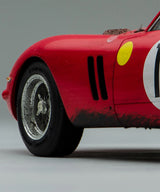- Limited to just 250 pieces
- Exactly as raced by Pierre Noblet and Jean Guichet at the 24 Hours of Le Mans on the 23rd and 24th of June 1962
- Weathering details precisely applied by artisans in Bristol using archival imagery
- Model accompanied by an archive quality GiclŽe print of the car during one of its final pits stops, selected from the Motorsport Images archives
- 1:18 scale model, over 24 cms/9 inches long
- Each model hand-built and assembled by a small team of craftsmen
- Made using the finest quality materials
- Over 800 hours to develop the base model
- Precisely engineered parts: castings, photo-etchings and CNC machined metal components
- Base model built using a digital scan of an original 250 GTO and paint codes supplied by Ferrari
The ultimate expression of the 250 GT series, the Ferrari 250 GTO model was the car that encapsulated Ferrari's philosophy best: achieving the highest level of performance and styling. Its famed charisma came not only from its innumerable racing victories but from the unique sum of its parts. A 2,953cc Columbo V12 engine coupled to a new 5-speed gearbox with a Sergio Scaglietti-designed body on top of a 250 GT chassis; the 250 GTO represented the pinnacle of 250 GT development in competition form, whilst remaining a legitimate road car. In recent years, original examples have repeatedly set price records. Chassis 3413 GT sold at auction in 2018 for $48.4 million and, later that same year, chassis 4153 GT was sold in a private sale for a reported $70 million.
The 250 GTO was built on a 2400mm wheelbase and, although the chassis was built along the same lines as the 250 GT SWB on which it was derived, it used smaller section tubing, with additional bracing for increased torsional rigidity. Four wheel disc brakes were fitted, with a cable-operated handbrake to the rear wheels. The 3-litre V12 power unit was essentially a 250 TR specification engine, producing a claimed power output of 300 bhp, which was paired with a new 5-speed, all synchromesh gearbox.
Early development of the new car was shrouded in secrecy, with Giotto Bizzarrini charged with developing a car to take on and beat the Jaguar E Type. On its first outing at Monza in September 1961, prior to the Italian Grand Prix, the 250 GTO earned the nickname 'Il Mostro' (The Monster), due to its rough-hewn and ill-fitting prototype body. During test sessions, Stirling Moss drove the car to record times far better than those ever achieved by a similar chassis. A 'palace revolution' followed later in the year, and Bizzarrini found himself on the outside, with the refinement of the GTO body now entrusted to Sergio Scaglietti, who created its definitive shape. The overall shape of the aluminium bodies designed and built by Scaglietti changed very little across the 36-car production run in 1962 and 1963, though the last three cars in the series, built in 1964, received Pininfarina-designed and Scaglietti-built bodies of a style very similar to that used on the mid-engine 250 LM sports racing car. Although the overall body shape didn't alter to any great degree, the detail differences during the production run certainly did, as refinements were made across the car's construction span.
Unveiled at the annual pre-season Ferrari press conference in January 1962, the 250 GTO was the sole front-engine model amongst a line-up of mid-engine racers. New owners needed to afford the $18,000 price tag, as well as be personally approved by Enzo Ferrari. On its maiden outing in the 12 Hours of Sebring Race, the 250 GTO, driven by Phil Hill and Olivier Gendebien, finished second overall to a Ferrari 250 Testa Rossa. It also won the GT category easily by a six-lap margin, an impressive debut performance that hinted at the dominant period to come. Ferrari would go on to secure the International Championship for GT Manufacturers comfortably in 1962 and 1963. The 250 GTO would complete the hat-trick in 1964 by smaller margin of six points, having only been caught by Shelby's competitive AC Cobras (with much larger V8 capacity engines) during its last competitive year.
Amongst the numerous international successes of the 250 GTO were victories in the Tour de France in 1963 and 1964, extending Ferrari's win streak to nine straight years; GT class wins in the Targa Florio in 1962, 1963 and 1964; victories in the Tourist Trophy at Goodwood in 1962 and 1963; with GT category wins at Le Mans in 1962 and 1963, and in the Nürburgring 1000 km in 1963 and 1964.






















